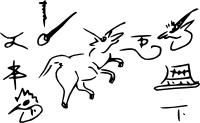Much like Aztec and Mixtec, Naxi Dongba is a highly pictographic communication system. Like Aztec and Mixtec, it’s almost not a writing system. If you look at a picture of the writing, it looks more like what we think of as “drawings” than as “writing”.
Indeed, this writing system is used less for communicating with other people and more with communicating to oneself and to the gods: it is mostly used as a mnemonic system by priests, and the edges of the book are burned as part of ceremonies. It is highly logographic (though the logograms are wildly idiosyncratic), with pictorial rebuses for words that don’t have a logogram.
After the revolution in China and then the Cultural revolution, Naxi Dongba nearly became extinct. The largest collections of Naxi Dongba manuscripts are those that had already left the country. It is still highly threatened.
Naxi Dongba, like Aztec and Mixtec, raises a question of “What is a writing system?” Today’s Wikipedia article on Writing Systems says “A writing system is a symbolic system used to represent elements or statements expressible in language.” But how much abstraction into symbols is required before it moves from drawing to writing? Does Naxi Dongba qualify? Do Renaissance religious paintings qualify? I do not know the answers.
Links: Wikipedia, Omniglot, Naxi Pictographic and Syllabographic Scripts, Sinoglot


Pingback: Naxi Geba — 1200 AD? S. China | Glyph of the Day
Pingback: Punjabi Landa — 900 AD, India | Glyph of the Day
Pingback: Gurmukhi — 1539 AD, India/Pakistan | Glyph of the Day